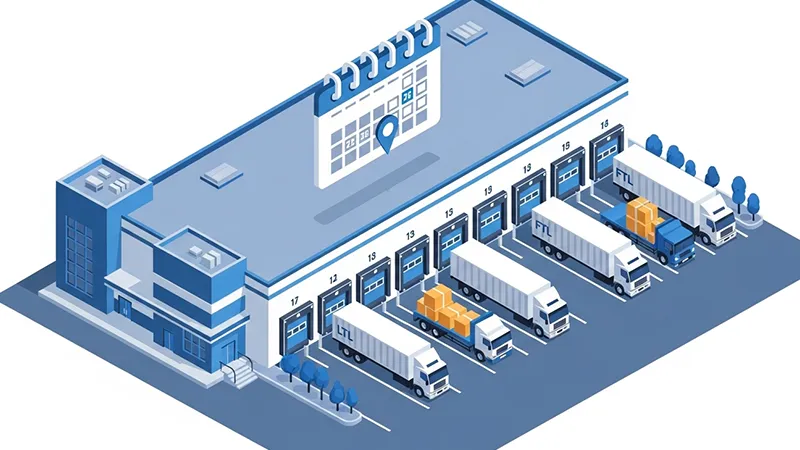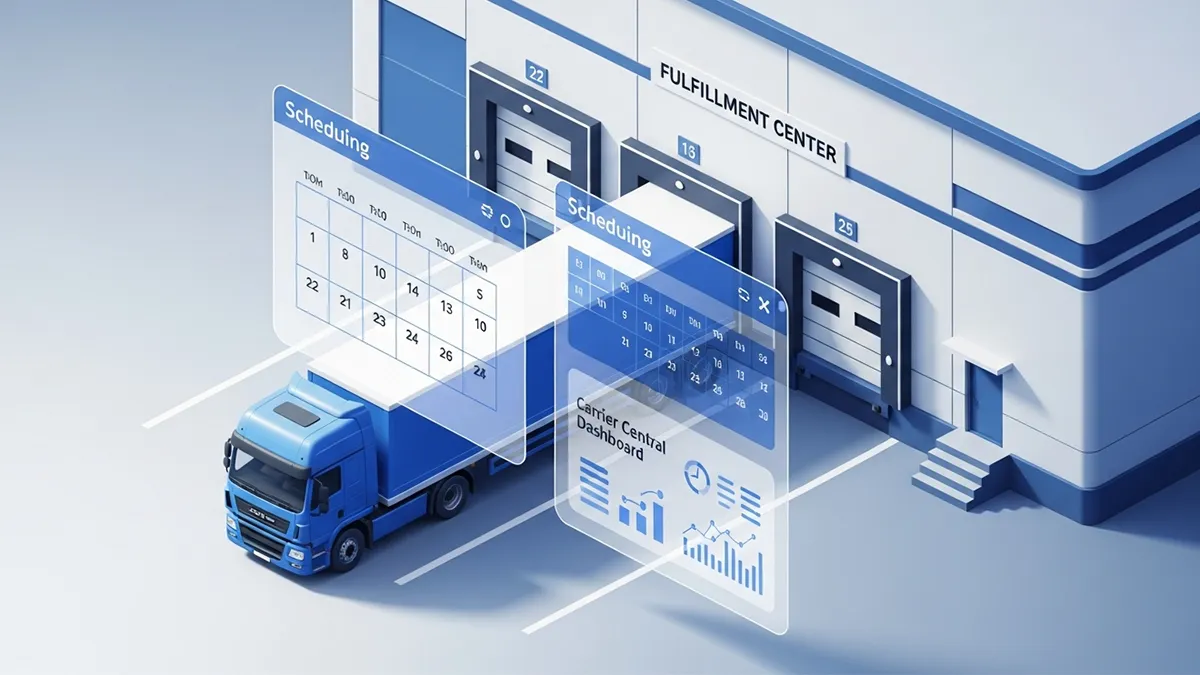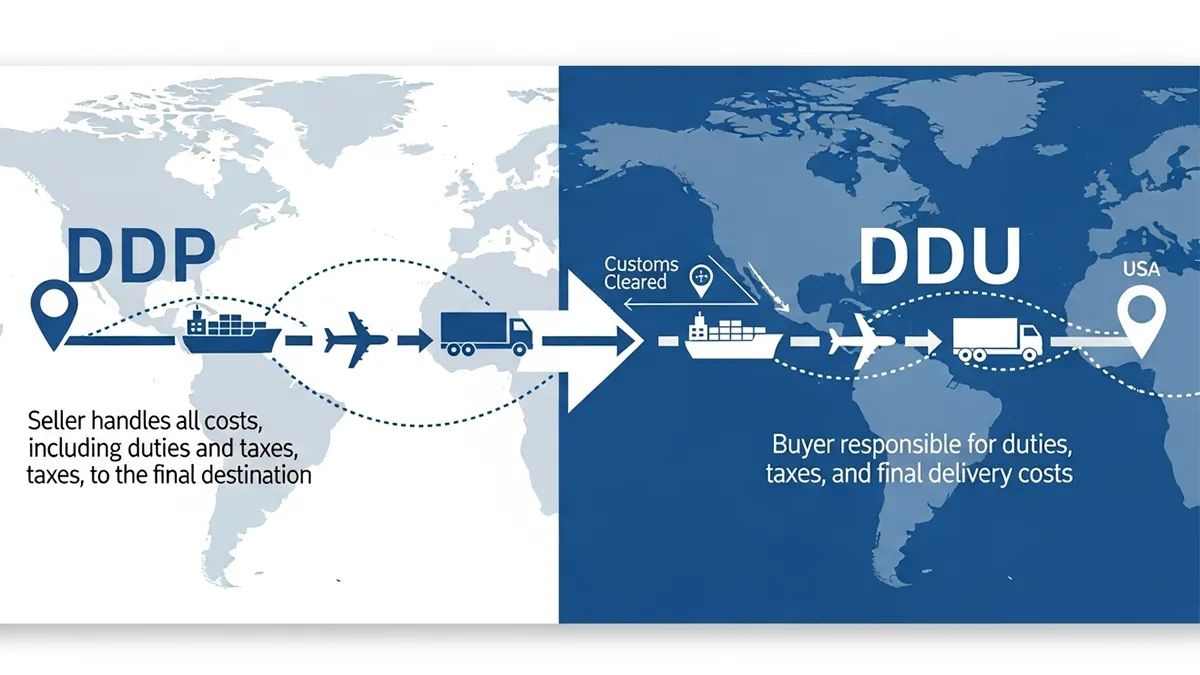Amazon FBA Appointment Scheduling (Carrier Central): The Complete 2025 Guide for Sellers
Inbound delivery appointments are one of the most misunderstood parts of Amazon FBA shipping—especially for sellers shipping from China to the United States. A truck arriving early, late, or without confirmation can result in rejections, long demurrage, additional trucking fees, or inventory check-in delays that last weeks.
This guide explains how Amazon’s appointment scheduling system actually works across FC/SC/DS nodes, what delays mean, and how to prevent failed delivery attempts. As a China-based freight forwarder with 25 years of experience, 100+ logistics staff, and our own U.S. customs brokerage and trucking fleet, Zbao Logistics has handled thousands of FBA inbound shipments and seen every possible edge case—this guide consolidates it all.
What “Delivery Appointment Scheduled” Actually Means
In Amazon terminology, a “delivery appointment scheduled” means a confirmed time slot has been booked for a truck to arrive at a Fulfillment Center (FC), Sort Center (SC), or Delivery Station (DS). This time slot is created through Carrier Central, or in some cases, Amazon Relay / integrated TSP systems.
It is not the same as Amazon’s ETA.
A shipment can have an ETA before Amazon accepts an appointment, and Amazon can also change or delay the appointment based on warehouse congestion.
Most FBA receiving delays during peak seasons—Prime Week, October Big Deal Days, Black Friday, or post-Christmas—are caused by congested appointment calendars rather than trucking issues.
How Amazon Appointment Scheduling Works (Step by Step)

1. Shipment is created inside Seller Central
The seller or forwarder generates an FBA shipment ID (e.g., FBA12345). Palletization and carton content labels are prepared at origin.
2. Freight forwarder handles transportation to the U.S.
Depending on the service—air, sea, DDP, UPS, LTL—the cargo arrives at a U.S. gateway such as LAX, ONT, JFK, ORD, IAH, or SDF.
3. Trucking partner requests an appointment in Carrier Central
Amazon will ask for:
-
Shipment ID
-
PO number
-
Trailer number
-
Appointment type (LTL/FTL/parcel)
-
Pallet count / carton count
-
Estimate arrival date
-
Driver & truck details (sometimes via Amazon Relay)
4. Amazon reviews and assigns a delivery time
This depends on:
-
Warehouse capacity
-
Staffing levels
-
Seasonal demand
-
Receiving backlog
-
Whether the shipment requires live unload or drop trailer
Often during Q4, Amazon automatically moves requests several days later than expected.
5. Appointment is confirmed; driver must meet strict rules
These rules include:
-
Arriving within the allowed window (often 30–60 minutes)
-
Bringing correct BOL and labels
-
Trailer sealing rules
-
Pallet height compliance
-
No mixed freight
If any rule is violated, Amazon may reject the truck.
For more details on general U.S. freight rules for FBA delivery, sellers can read Amazon’s official guidance here:
FBA Inbound Appointment Requirements.
Why Appointment Delays Happen (Real Causes)
After handling thousands of FBA shipments, the most common reasons include:
1. Appointment calendar fully booked
This happens frequently at:
-
ONT8
-
LGB8
-
MDW2
-
ABE8
-
FTW1
-
SMF3
Peak seasons can push availability 5–12 days later.
2. Amazon requests additional data or corrections
Wrong pallet count, incorrect trailer number, missing PRO number, etc.
3. Trailer type or carrier not accepted
Amazon sometimes restricts:
-
20ft containers
-
Certain independent trucking companies
-
Trucks without Amazon Relay approval
4. Live unload capacity issues
Live unload trailers require labor, so Amazon pushes them back.
5. SC/DS locations with smaller docks
Sort Centers have fewer dock doors than FC warehouses, causing congestion.
How to Prevent FBA Appointment Delays

Here’s what Zbao Logistics recommends (based on real operational data):
1. Use pallet standards Amazon prefers
-
40” x 48” pallets
-
Max height 72–78 inches (varies by FC)
-
Shrink wrapped, labeled, no overhang
Non-compliant pallets almost always delay scheduling.
2. Let a professional forwarder manage Carrier Central
Most sellers do not know that 70%+ of delays come from incomplete data submitted by inexperienced truckers.
3. Ship earlier than competitors
For Q4, aim for:
-
By Sept 15 for general goods
-
By Oct 1 for peak events
-
By Nov 1 latest for Christmas
4. Consider FCL → FBA transfer via 3PL
If Amazon calendar is full, Zbao can temporarily unload at our U.S. warehouses and deliver later as LTL.
5. Track the shipment correctly
You can read our detailed inbound shipping SOP here: China-to-FBA Shipping Guide.
Amazon Delivery Appointment Statuses (Explained)
“Delivery Appointment Scheduled”
Your time slot is confirmed.
“Appointment Pending” / “No Appointment Available”
Amazon has not approved your request yet. This is common during Q4.
“Rescheduled by Amazon”
Amazon moved your appointment due to capacity issues.
“Delivery Rejected”
Driver arrived:
-
Early
-
Late
-
Without the correct BOL
-
With damaged pallets
-
With mixed freight
-
With incorrect shipment ID
This often results in extra trucking redelivery fees.
How to Change or Reschedule an Appointment
Only the carrier or freight forwarder can request a change through Carrier Central.
Common rescheduling reasons:
-
Trailer breakdown
-
Driver hours-of-service (HOS) limits
-
Weather
-
Amazon request for documentation correction
If the truck misses the window, Amazon usually pushes the appointment 2–7 days later.
Best Practices for FBA Appointments (Zbao Logistics Recommendations)
1. Always schedule before cargo leaves China
This helps align arrival dates with Amazon calendar congestion.
2. Avoid Monday morning appointments
Amazon has the longest backlog.
3. Choose drop-trailer FCs when possible
They process faster during busy periods.
4. Use forwarders with their own trucks in the U.S.
At Zbao Logistics, our in-house U.S. trucking network reduces dependence on third-party carriers and speeds up appointment acceptance.
How FBA Appointment Scheduling Affects Your Inventory Check-in Speed
Appointment timing influences:
-
FC dock velocity
-
Check-in priorities
-
Scan-to-receive speed
-
Stock-out risk
-
Buy Box performance
Shipments arriving late or rescheduled can take 7–15+ days to check in. For sellers moving replenishment inventory, this can directly reduce revenue.
FAQ: Amazon FBA Appointment Scheduling (Carrier Central)
1. What is an Amazon FBA delivery appointment?
An FBA delivery appointment is a scheduled time window required by Amazon for carriers to deliver inbound freight to a fulfillment center. Amazon only accepts trucks that have a confirmed appointment in Carrier Central; walk-in deliveries are not allowed.
2. Who is responsible for booking the Amazon FBA appointment — the shipper, carrier, or freight forwarder?
Amazon requires the carrier to schedule the appointment via Carrier Central.
However, most sellers rely on their freight forwarder (like Zbao Logistics) to handle the entire booking process, submit shipment details, and coordinate with Amazon’s receiving team.
3. What documents or information are required to book an appointment?
Carriers typically need:
-
Amazon FBA Shipment ID
-
ASN or BOL
-
Carton or pallet count
-
Trailer size and transportation mode (LTL/FTL)
-
FC code (e.g., ONT8, LAX9, TEB3)
-
Preferred delivery window
Without a correct Shipment ID or accurate carton count, Amazon may reject or delay the request.
4. How long does Amazon take to approve an appointment?
Approval time varies by season and FC congestion:
-
Normal periods: 24–72 hours
-
Peak season (Oct–Jan): 4–7 days or longer
-
Oversized or mixed SKUs: may require manual review
Zbao Logistics monitors every appointment request and follows up with the FC if approval is delayed.
5. Why is my status showing “Delivery Appointment Pending”?
This means the carrier has submitted the appointment request, but Amazon has not yet approved it.
Common reasons include:
-
FC is fully booked
-
Mismatch between submitted and actual carton/pallet quantity
-
Missing FBA Shipment ID
-
High season congestion
-
Restricted receiving times (e.g., weekends)
If it stays pending longer than 3–5 days, contact your carrier or freight forwarder.
6. What happens if the truck misses the Amazon appointment?
Amazon may:
-
Reject the load
-
Require a new appointment (1–5 days later)
-
Charge detention fees from the trucking company
-
In peak season, delay receiving by a full week
Professional forwarders like Zbao Logistics reduce this risk by coordinating with carriers, verifying all labels/cartons, and using our U.S. customs brokerage + trucking network to ensure on-time arrival.
Zbao Logistics: FBA Appointment Handling for China-to-USA Imports
With:
-
25+ years logistics experience
-
100+ full-time staff
-
In-house U.S. customs brokerage
-
Self-owned trucking fleet (LTL + FTL)
-
Dedicated Amazon FBA delivery team
We specialize in:
-
DDP air & sea shipping
-
LTL/FTL delivery into Amazon FCs
-
Peak season congestion handling
-
Re-delivery support
-
Temporary storage in U.S. warehouses
If you’re new to FBA logistics or scaling, refer to our complete guide: Shipping from China to Amazon FBA.
You can also review:
-
Amazon’s official inbound scheduling rules:
-
UPS freight inbound appointment explanation:
These references help sellers compare how general logistics networks manage scheduling compared to Amazon’s tighter FC controls.
Conclusion
Amazon FBA appointment scheduling is not simply picking a delivery time—it is a capacity-based system that directly affects your check-in speed, Buy Box stability, and replenishment strategy. Understanding how appointments are created, why they get delayed, and how to prevent rejections gives you a competitive advantage, especially when shipping from China.
Zbao Logistics supports Amazon sellers with complete China-to-USA FBA solutions, including customs, trucking, and full appointment scheduling management through Carrier Central and Amazon Relay.
If you want help optimizing your inbound workflow, feel free to reach out anytime.


